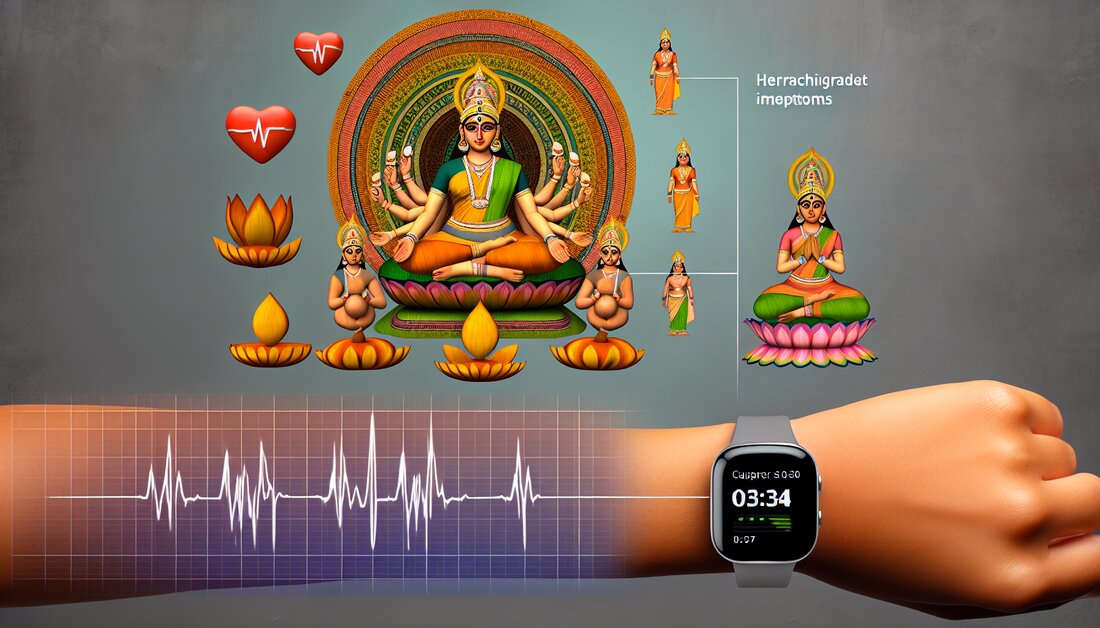Arogya Rakshak Panchatantra relieves dysmenorrhea: heart rate and symptoms improved
A study shows: Arogya Rakshak Panchatantra (ARP) can improve heart rate variability and menstrual cramps in dysmenorrhea. Significant advances in pain reduction!

Arogya Rakshak Panchatantra relieves dysmenorrhea: heart rate and symptoms improved
Primary dysmenorrhea (PD) refers to painful menstrual cycles that often lead to reduced performance and quality of life in young adults. This pain typically occurs during the first few days of menstruation and can cause significant physical and emotional distress. A recent study examined the effectiveness of a naturopathic lifestyle program called Arogya Rakshak Panchatantra (ARP) in young women with PD.
In this study, 52 young women aged 16 to 25 were divided into two groups. One group practiced the ARP program for a period of two months, while the other group maintained their usual lifestyle. During the examination, the participants' heart rate variability (HRV), pain intensity and quality of life were measured, among other things. The results showed that the ARP program led to an improvement in certain health parameters, particularly in the “high frequency” (HR) component of heart rate variability, a reduction in weight and a reduction in pain intensity.
The improvements in HRV suggest that the ARP program could positively impact the autonomic nervous system, which in turn could mean less menstrual pain. Reducing pain intensity and weight could also contribute to increasing well-being. While there were no significant changes in some measured areas such as quality of life or daytime sleepiness, the study still demonstrated that ARP may represent a potential management option for PD.
In the future, the use of naturopathic lifestyle therapies such as ARP may be increasingly considered in the treatment of PD, particularly when conventional treatments do not provide desired results or unwanted side effects occur. However, since the number of study participants was relatively small, further research with larger sample sizes is necessary to confirm these results and definitively define the role of ARP in the pain treatment of PD.
Basic terms and concepts
- Primäre Dysmenorrhoe (PD): Schmerzhafte Menstruationszyklen ohne erkennbare organische Ursache, die häufig bei jungen Frauen auftreten.
- Arogya Rakshak Panchatantra (ARP): Ein Lebensstilprogramm, das auf naturheilkundlichen Prinzipien basiert und darauf abzielt, gesundheitliche Probleme durch natürliche Praktiken zu lindern.
- Herzfrequenzvariabilität (HRV): Ein Maß für die Variation in Zeitabständen zwischen aufeinanderfolgenden Herzschlägen, das einen Hinweis auf die Balance im autonomen Nervensystem gibt.
- High Frequency (HF): Ein spezifischer Bereich der HRV, der oft mit der Aktivität des parasympathischen Nervensystems in Verbindung gebracht wird, welches für Ruhe und Verdauung zuständig ist.
- Visuelle Analogskala (VAS): Ein Tool zur Bewertung der Schmerzintensität, bei dem Teilnehmer angeben, wie stark ihr Schmerz auf einer Skala von „kein Schmerz“ bis „stärkster vorstellbarer Schmerz“ ist.
Abbreviations
- PD: Primäre Dysmenorrhoe
- ARP: Arogya Rakshak Panchatantra
- HRV: Herzfrequenzvariabilität
- HF: High Frequency
- VAS: Visuelle Analogskala
Efficacy of Arogya Rakshak Panchatantra in primary dysmenorrhea
The present study examines the effectiveness of Arogya Rakshak Panchatantra (ARP), a naturopathic lifestyle, in young women with primary dysmenorrhea (PD). The research was conducted as an open-label, parallel, randomized controlled trial and included 52 young women aged 16 to 25 years.
Study structure and methodology
The participants were randomly divided into two groups: the ARP group, which practiced the ARP module for two months, and the control group, which maintained their usual lifestyle. The primary outcome measure was change in heart rate variability (HRV). Secondary measures included menstrual symptoms, quality of life, pain perception, and daytime sleepiness. These were assessed at the start of the study and during the first three menstrual cycles in both groups. To evaluate feasibility, self-reported symptoms, emotions, adverse events, caloric intake, and adherence to the intervention were also monitored.
Results
In the intervention group, significant improvements in high-frequency HRV (p = 0.007) as well as reductions in weight (p = 0.017), pain perception on the visual analog scale (p = 0.000) and retrospective symptom scale score (p < 0.011) were observed. There were no significant changes in other HRV metrics, quality of life, or daytime sleepiness. Participants reported mild symptoms such as headache, cold, body aches, diarrhea, constipation, fever and weakness, but no serious adverse events occurred.
Conclusions
This study is the first research to examine the long-term effects of ARP on young women with PD. The results suggest that ARP could be an effective and feasible management option. Nevertheless, further research with larger samples is needed to confirm these findings.
For more information about the study, please visit: https://pubmed.ncbi.nlm.nih.gov/39705086.

 Suche
Suche
 Mein Konto
Mein Konto
